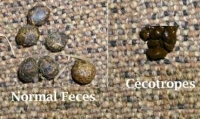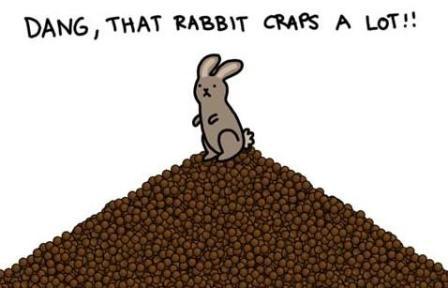For one thing, rabbits eat grass. Usually animals that eat grass are large and have complex multi-chamber stomachs (think of cows) and very long intestines (sheep), or a very large cecum (horses). Cellulose is difficult to digest, and herbivores use some help from intestinal bacteria. The bacteria are slow, though, so the food usually remains in these large fermentation chambers for a long time.
But rabbits are small. They have a single small stomach, and as much intestines as they can pack into their small bodies, and as large a cecum as they can get. But that is not enough – the food, half digested, passes through them too fast. What a waste of energy!
So they have to do something that you and I may find distasteful, but rabbits apparently enjoy – coprophagy! Yes, they eat their own feces.
But there is a trick to it. Food goes through the rabbit twice. Not once, not three or four times, just twice. How do the rabbits accomplish that?
The droppings that passed through the rabbit only once – caecotrophs – are small and soft and clumped up like grapes. They are apparently yummy to rabbits and get eaten. Droppings that made the passage through the rabbit twice are larger, separate from each other, and dry.
Interestingly, they mostly defecate dry droppings in the morning, and soft droppings in the evening.
And the timing of excretion of these two types of feces is under the control of the circadian clock – the rhythm (and the separation between timing of soft and dry pellets) persists in constant darkness, can be entrained by light-dark cycles, and can be entrained by feeding cycles (Refs, 1, 4, 5, 6).
It is interesting to me that much of this research was done a long time ago – in the 1940s for the feces composition and the 1970s for the circadian rhythms (including comparative studies in other animals, e.g., rodents that have a similar system, Refs. 2-3). I guess it would be hard to get funding for this kind of research in today’s climate. Though, understanding that the food passes through the rabbits twice, and the temporal dynamics of the process, is important for studies like this one – monitoring the spread of radioactivity from a spill site by monitoring the radioactivity in rabbit pellets in the countryside.
References:
1. Bellier R, Gidenne T, Vernay M, & Colin M (1995). In vivo study of circadian variations of the cecal fermentation pattern in postweaned and adult rabbits. Journal of animal science, 73 (1), 128-35 PMID: 7601725
2. Kenagy, G., & Hoyt, D. (1979). Reingestion of feces in rodents and its daily rhythmicity Oecologia, 44 (3), 403-409 DOI: 10.1007/BF00545245
3. Kenagy GJ, Veloso C, & Bozinovic F (1999). Daily rhythms of food intake and feces reingestion in the degu, an herbivorous Chilean rodent: optimizing digestion through coprophagy. Physiological and biochemical zoology : PBZ, 72 (1), 78-86 PMID: 9882606
4. Hörnicke H, Ruoff G, Vogt B, Clauss W, & Ehrlein HJ (1984). Phase relationship of the circadian rhythms of feed intake, caecal motility and production of soft and hard faeces in domestic rabbits. Laboratory animals, 18 (2), 169-72 PMID: 6748594
5. Pairet M, Bouyssou T, & Ruckebusch Y (1986). Colonic formation of soft feces in rabbits: a role for endogenous prostaglandins. The American journal of physiology, 250 (3 Pt 1) PMID: 3456721
6. Hörnicke, H., Batsch, F., & Hornicke, H. (1977). Coecotrophy in Rabbits: A Circadian Function Journal of Mammalogy, 58 (2) DOI: 10.2307/1379586
















Pingback: Carnal Carnival #1 – Essentials of Elimination | A Blog Around The Clock
¡qué comemierda ese conejo! 🙂
Having two pet rabbits, I’ve always wondered how they tell which poop is to be eaten and which is to be left alone. They sometimes ingest it as they are pooping (like, literally as it’s coming out of their anus,) so it might be more than just an olfactory/textural cue – maybe they can feel the difference.
Oh, I don’t know.
It’s timing. If it’s the evening, it’s time to poop soft and to eat it. If it’s morning, the poop is dry and to be left alone.
I’m sure that once upon a time I knew this but never thought about it much… And now I have another coll fact to throw at people at a boring party… “Did you know …”
That is really interesting! I had no idea that rabbits weren’t indiscriminate coprophag…-ors? -ites? -ists? If their lower gut’s like ours and sucks water out at a roughly constant rate, and if they’re diurnal, it makes sense that they’d poop dry after their inactive period and moist after their food-gathering period. What a perfect, logical thing to regulate with a central cl0ck.
So what happens if you give the rabbit a *competing* zeitgeber? Light-entrain them but feed them at night?
Pingback: Bunnyblogging, redux… « Terpsinoe
Pingback: Best of August 2010 | A Blog Around The Clock
Pingback: 2010 in review | A Blog Around The Clock
Pingback: Rabbit Cage VS Hutch ? Which Is Better? « Hutchy Kate Grin's Blog